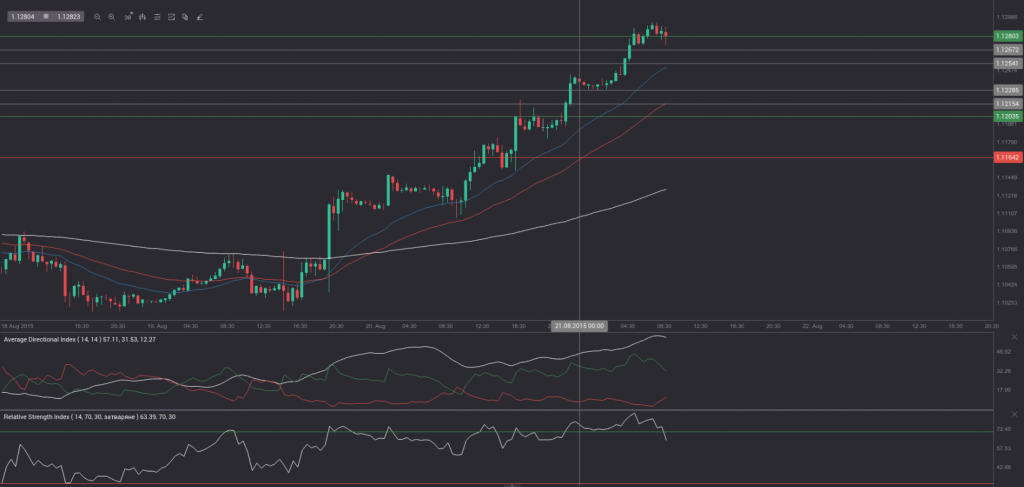Yesterday’s trade saw EUR/USD within the range of 1.1105-1.1245. The pair closed at 1.1241, soaring 1.10% on a daily basis, or the most considerable daily gain since July 27th, when it appreciated 1.11%. The daily high has been the highest level since June 30th, when the cross registered a high of 1.1245.
At 6:45 GMT today EUR/USD was up 0.33% for the day to trade at 1.1277. The pair is set to test the upper range breakout level (R4), as it touched a daily high at 1.1295 at 5:30 GMT. It has been the highest level since June 23rd, when the cross reached a daily high of 1.1348.
Today the cross may be influenced by a number of macroeconomic reports as listed below.
Fundamentals
Euro area
Manufacturing, Services PMIs by Markit – preliminary estimates
German manufacturing Purchasing Managers Index probably remained little changed in August, with the preliminary index value being at 51.7. If so, this would be the ninth consecutive month, during which the PMI inhabited the area above 50.0. In July the PMI came in at a final 51.8, up from a preliminary reading of 51.5. The flash value is due out at 7:30 GMT.
Activity in German services sector probably showed a slight improvement in August, with the preliminary PMI rising to 54.0 from a final reading of 53.8 in July. If so, this would be the 27th consecutive month, when the PMI stood in the zone of expansion and also the highest PMI level since April 2015, when the indicator stood at a final 54.0. The preliminary data is to be released at 7:30 GMT.
Manufacturing activity in the whole Euro region probably slowed down a second straight month in August, with the preliminary Purchasing Managers Index coming in at 52.2. If so, this would be the 26th consecutive month of expansion, but also the lowest index reading since May. In July the gauge stood at a final 52.4, up from a preliminary reading of 52.2. The PMI reflects the performance of the manufacturing sector in the area and is based on a survey of 3 000 manufacturing companies. National data are included for Germany, France, Italy, Spain, the Netherlands, Austria, the Republic of Ireland and Greece. These member states together account for almost 90% of Euro zones manufacturing activity. The Manufacturing Purchasing Managers Index is comprised by five individual indexes with the following weights: New Orders (30%), Output (25%), Employment (20%), Suppliers’ Delivery Times (15%) and Stock of Items Purchased (10%), as the Delivery Times index is inverted, so that it moves in a comparable direction. The preliminary data is expected at 8:00 GMT.
The preliminary services PMI in the Euro area was probably unchanged in August compared to a month ago at a level of 54.0. In June the final reading of the index was reported to have been at 54.4, confirming the preliminary estimate and also being the highest index level since May 2011, when the final services PMI was reported at 56.0. If market expectations were met, August would be the 25th consecutive month, during which the index stood above the key level of 50.0. The PMI is based on data collected from a representative panel of around 2 000 private service sector companies. National services data are included for Germany, France, Italy, Spain and the Republic of Ireland. The survey represents private sector conditions in terms of new orders, output, employment, prices etc. Markit will release the preliminary data at 8:00 GMT.
A better-than-expected performance in any of the PMI readings would certainly provide support to the common currency.
Consumer Confidence Index – preliminary estimate
Confidence among consumers in the Euro area probably showed a slight improvement in August. The preliminary value of the consumer confidence index probably rose to -6.9 from a final value of -7.1 in July. The latter was a confirmation of the preliminary index reading reported on July 23rd. The index measures consumer confidence on a scale of -100 to +100. A reading of -100 suggests a lack of confidence, zero means neutrality and a reading of +100 indicates extreme levels of confidence. The index reflects the level of optimism, which consumers have about economic development in the region. The Business and Consumer Survey is conducted by phone and includes 23 000 households in the Euro area. The questions asked stress on current economic and financial situation, savings intention and also on expected developments regarding consumer price indexes, general economic situation and major purchases of durable goods. This indicator is one of the five major components, that comprise the Economic Sentiment Indicator (ESI).
Higher confidence usually implies greater willingness to spend, including large-ticket purchases, while consumer spending is among the key factors driving economic growth. Therefore, in case the consumer confidence index improved more than anticipated, this would cause a moderate bullish impact on the euro. The European Commission is expected to release the preliminary reading at 14:00 GMT.
United States
Manufacturing PMI by Markit – preliminary estimate
Manufacturing activity in the United States probably increased a second consecutive month in August, with the corresponding preliminary Purchasing Managers Index coming in at a reading of 54.0, according to market expectations. In July the final seasonally adjusted PMI stood at 53.8, while being in line with the preliminary reading.
According to Markits statement: ”Stronger rates of output and new business growth were the main factors boosting the headline PMI reading in July. Production volumes expanded at the sharpest pace for three months, with survey respondents generally citing improved domestic demand conditions. Moreover, manufacturers commented on continued investments in new products and efforts to boost operating capacity, while some suggested that reshoring strategies had also provided a tailwind to growth at their plants.”
”…new business levels expanded at a strong pace that was the fastest recorded for four months. The latest survey also pointed to an increase in new export sales, which contrasted with the declines seen in each of the previous three months. However, the rate of new export order growth was only marginal, with some manufacturers noting that the strong dollar and an improving U.S. economy had encouraged them to focus sales efforts on domestic markets. July data pointed to a solid increase in payroll numbers, which continued the upward trend seen through much of the past five-and-a-half years.”
Values above the key level of 50.0 indicate optimism (expanding activity). In case the flash manufacturing PMI showed a better-than-anticipated performance, this would have a moderate bullish effect on the US dollar. The preliminary data by Markit Economics is due out at 13:45 GMT.
Bond Yield Spread
The yield on German 2-year government bonds went as high as -0.251% on August 20th, after which it slid to -0.259% at the close to lose 0.005 percentage point on a daily basis, while marking a second straight trading day of decline.
The yield on US 2-year government bonds climbed as high as 0.682% on August 20th, after which it fell to 0.665% at the close to add 0.004 percentage point for the day.
The spread between 2-year US and 2-year German bond yields, which reflects the flow of funds in a short term, widened to 0.924% on August 20th from 0.915% during the prior day. The August 20th yield difference has been the most notable one since August 18th, when the spread was 0.974%.
Meanwhile, the yield on German 10-year government bonds soared as high as 0.618% on August 20th, after which it slid to 0.582% at the close to depreciate 5.1 basis points (0.051 percentage point) compared to August 19th, while marking a second consecutive day of decrease.
The yield on US 10-year government bonds climbed as high as 2.134% on August 20th, after which it slipped to 2.078% at the close to lose 5.1 basis points (0.051 percentage point) on a daily basis, while marking a second consecutive day of decrease.
The spread between 10-year US and 10-year German bond yields was unchanged at 1.496% on August 20th. It has been the lowest difference since July 3rd, when the spread was 1.478%.
Daily and Weekly Pivot Levels
By employing the Camarilla calculation method, the daily pivot levels for EUR/USD are presented as follows:
R1 – 1.1254
R2 – 1.1267
R3 (range resistance – green on the 30-minute chart) – 1.1280
R4 (range breakout – red on the 30-minute chart) – 1.1318
S1 – 1.1228
S2 – 1.1215
S3 (range support – green on the 30-minute chart) – 1.1203
S4 (range breakout – red on the 30-minute chart) – 1.1164
By using the traditional method of calculation, the weekly pivot levels for EUR/USD are presented as follows:
Central Pivot Point – 1.1081
R1 – 1.1238
R2 – 1.1370
R3 – 1.1527
S1 – 1.0949
S2 – 1.0792
S3 – 1.0660






